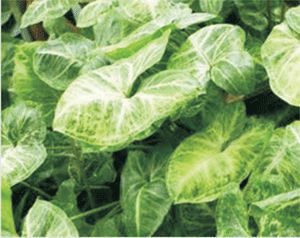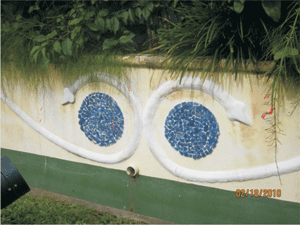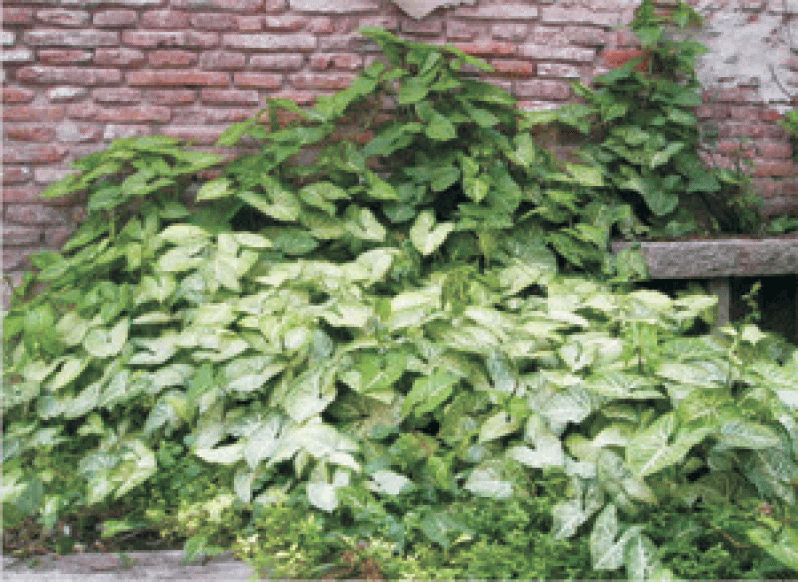The ‘Arrowhead Plant’ hits bullseye for beauty and utility
SYNGONIUM podophyllum, the “Arrowhead Plant”, is not only good for decorative purposes, but is listed among the top ten of the United States National Aeronautics and Space Administration (NASA) agency’s list of plants which reduce airborne microbes, increase humidity and induce positive psychological effects on the planter.  Thus the plant is useful for cleaning and purifying air in the home or office.
Thus the plant is useful for cleaning and purifying air in the home or office.
Syngonium podophyllum is a vine which is a tropical climber in the Arum (or aroid) family, and is native to tropical rain forests in Central and South America. The leaves of the Syngonium begin with an “arrowhead” shape, then change into three to five finger-like sections as the plant matures.
Used as a houseplant since the late 19th century, Syngonium is perfect in a modern living room, and can achieve spectacular results if grown in a pot with colour similar to the leaves of the plant. Its beautiful lush vegetation, with the tendrils coming from under the sheltering leaves, is reminiscent of a tropical rainforest.
When placed in a dark corner of the room, the white of the leaves will slowly turn into green; but replaced in the light, the original colours will re-appear.
Syngonium can be used in the home as a trailing plant, or it can be trained to ascend a pole or moss stick. The plant has been known to exceed its heights of 10 to 20 metres when grown on a tree. Syngoniums are perfect for a sunroom or greenhouse conservatory, where ample heat, light and humidity will encourage their tropical nature.
Mr. Hans Neher, Horticulturalist of the # 1 Flowershop (Tele # 227-8094) advises that since the Syngonium is a rainforest plant, it should be grown with a thick mulch, which can absorb a lot of moisture, and this would result in the plant growing bigger and better.
Neher says that to get the Syngonium up and running, gardeners need to spray it from time to time with foliage fertilizer 15-15-15 (a water soluble salt in one to two teaspoonsful per litre of water).
He added “Since the leaves are relatively large and thin, we have to monitor them to prevent any growth of fungus. If any fungus growth appears on the edges of the plant leaves, add ½ spoon of fungicide to your regular fertilizer application, and the fungus attack will disappear in no time.”
Planters In a general tip for gardening from Neher Designs of the # 1 Flowershop, Neher also advised: “On this occasion, we would like to suggest to our house and garden friends to reduce their accumulation of flower pots and think about a concrete planter along a wall or the perimeter fence.”
In a general tip for gardening from Neher Designs of the # 1 Flowershop, Neher also advised: “On this occasion, we would like to suggest to our house and garden friends to reduce their accumulation of flower pots and think about a concrete planter along a wall or the perimeter fence.”
He explained: “First of all, the concrete planter can add a piece of beauty to your environment by establishing a design on the front surface and the top of the planter rim (see picture). Secondly, it is easier to maintain, and the plants which can be planted in family groups will enjoy the larger earth volume in the planter, which will help to make plants bigger and heavier flowering. Additionally, you can widen your plant picture by incorporating the back wall of your planter with a wooden lattice (we say wooden lattice, don’t take the ugly plastic). The lattice incorporated into the concrete planter will help especially climbing plants such as syngoniums, yellow flowering mandevillas, macaw tail with red long flower stems, and other climbers to provide you with a picture perfect garden.
“And by the way,” he further advised, “consider weep holes on the bottom of your planter, that the excess water which we get in the rainy season can be freely drained from the planter.”



.jpg)









